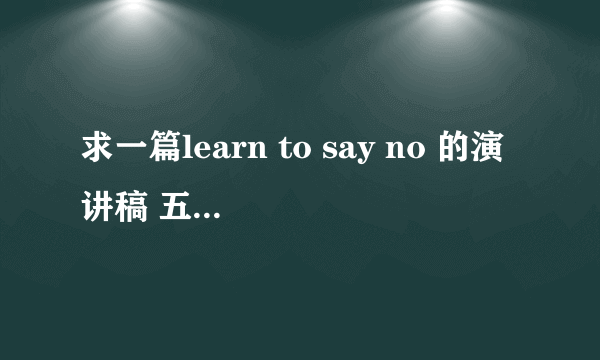求一篇learn to say no 的演讲稿 五分钟的哦
的有关信息介绍如下:
第一篇。。Learning to say NO Saying NO can be very difficult. People with low self-esteem very often have a lack of assertiveness and think they have to meet the expectations of everyone. It is very hard for them to set limits with others. They sometimes feel ashamed or guilty if they would say NO. But to do things against your will and possibilities will end up in feeling used and resentful. A simple and direct "NO, I am not able to help you with that" is the best solution. If you want to (have to) give an explanation you should keep it simple:"NO, I have already made an another appointment for this time" or "NO, sorry. I am afraid I have to decline because I have no spare time." Other ways of saying NO: I can´t do this right now. NO, thanks. Not this time. Thank you for asking. Sorry, but NO. Please accept that I cannot come. I´d rather not. To say an assertive NO you should: Start the sentence with the word NO Shake your head and use nonverbal assertiveness to underline your NO. Your voice should be clear and direct. Keep eye contact. If someone makes a request it is fair to ask for time to think it over. The decision should be up to you, but sometimes it is difficult to say NO right now. You can try to use an empathic NO, if you would have helped under different circumstances: "Sorry, no. I would have kept your cat next weekend. But my husband and I will be off for visit. I know it will be hard to find someone to take care off the cat. I will try to help you next time." Remember : Saying NO is a very honourable response. You have the right to say "No"!第二篇7 Simple Ways To Say “No”Editor’s note: This is a guest post from Celestine Chua of The Personal Excellence Blog. Do you have difficulty saying “no”? Are you always trying to be nice to others at the expense of yourself? Well, you’re not alone. In the past, I was not good at saying “no”, because I didn’t want to hurt the other person’s feelings. For example, whenever I get requests for help, I would attend to them even though I had important work to do. Sometimes the requests would drag to 2-3 hours or even beyond. At the end of the day, I would forgo sleep to catch up on my work. This problem of not knowing how to say “no” also extended to my clients, business associates and even sales people. After a while, I realized all these times of not saying “no” (when I should) were not helping me at all. I was spending a lot of time and energy for other people and not spending nearly as much time for myself. It was frustrating especially since I brought it upon myself. I slowly realized if I wanted personal time, I needed to learn to say “no”. Why We Find It Hard To Say “No” To learn to say “No”, we have to first understand what’s resisting us about it. Below are common reasons why people find it hard to say no: 1.You want to help. You are a kind soul at heart. You don’t want to turn the person away and you want to help where possible, even if it may eat into your time. 2.Afraid of being rude. I was brought up under the notion that saying “No”, especially to people who are more senior, is rude. This thinking is common in Asia culture, where face-saving is important. Face-saving means not making others look bad (a.k.a losing face). 3.Wanting to be agreeable. You don’t want to alienate yourself from the group because you’re not in agreement. So you confirm to others’ requests. 4.Fear of conflict. You are afraid the person might be angry if you reject him/her. This might lead to an ugly confrontation. Even if there isn’t, there might be dissent created which might lead to negative consequences in the future. 5.Fear of lost opportunities. Perhaps you are worried saying no means closing doors. For example, one of my clients’ wife was asked to transfer to another department in her company. Since she liked her team, she didn’t want to shift. However, she didn’t want to say no as she felt it would affect her promotion opportunities in the future. 6.Not burning bridges. Some people take “no” as a sign of rejection. It might lead to bridges being burned and relationships severed. If you nodded to any of the reasons, I’m with you. They applied to me at one point or another. However, in my experience dealing with people at work and in life, I realized these reasons are more misconceptions than anything. Saying “No” doesn’t mean you are being rude; neither does it mean you are being disagreeable. Saying “No” doesn’t mean there will be conflict nor that you’ll lose opportunities in the future. And saying no most definitely doesn’t mean you’re burning bridges. These are all false beliefs in our mind. At the end of the day, it’s about how you say “no”, rather than the fact you’re saying no, that affects the outcome. After all, you have your own priorities and needs, just like everyone has his/her own needs. Saying no is about respecting and valuing your time and space. Say no is your prerogative. 7 Simple Ways To Say “No” Rather than avoid it altogether, it’s all about learning the right way to say no. After I began to say no to others, I realized it’s really not as bad as I thought. The other people were very understanding and didn’t put up any resistance. Really, the fears of saying no are just in our mind. If you are not sure how to do so, here are 7 simple ways for you to say no. Use the method that best meets your needs in the situation. 1. “I can’t commit to this as I have other priorities at the moment.” If you are too busy to engage in the request/offer, this will be applicable. This lets the person know your plate is full at the moment, so he/she should hold off on this as well as future requests. If it makes it easier, you can also share what you’re working on so the person can understand better. I use this when I have too many commitments to attend to. 2. “Now’s not a good time as I’m in the middle of something. How about we reconnect at X time?” It’s common to get sudden requests for help when you are in the middle of something. Sometimes I get phone calls from friends or associates when I’m in a meeting or doing important work. This method is a great way to (temporarily) hold off the request. First, you let the person know it’s not a good time as you are doing something. Secondly, you make known your desire to help by suggesting another time (at your convenience). This way, the person doesn’t feel blown off. 3. “I’d love to do this, but …” I often use this as it’s a gentle way of breaking no to the other party. It’s encouraging as it lets the person know you like the idea (of course, only say this if you do like it) and there’s nothing wrong about it. I often get collaboration proposals from fellow bloggers and business associates which I can’t participate in and I use this method to gently say no. Their ideas are absolutely great, but I can’t take part due to other reasons such as prior commitments (#1) or different needs (#5). 4. “Let me think about it first and I’ll get back to you.” This is more like a “Maybe” than a straight out “No”. If you are interested but you don’t want to say ‘yes’ just yet, use this. Sometimes I’m pitched a great idea which meets my needs, but I want to hold off on committing as I want some time to think first. There are times when new considerations pop in and I want to be certain of the decision before committing myself. If the person is sincere about the request, he/she will be more than happy to wait a short while. Specify a date / time-range (say, in 1-2 weeks) where the person can expect a reply. If you’re not interested in what the person has to offer at all, don’t lead him/her on. Use methods #5, #6 or #7 which are definitive. 5. “This doesn’t meet my needs now but I’ll be sure to keep you in mind.” If someone is pitching a deal/opportunity which isn’t what you are looking for, let him/her know straight-out that it doesn’t meet your needs. Otherwise, the discussion can drag on longer than it should. It helps as the person know it’s nothing wrong about what he/she is offering, but that you are looking for something else. At the same time, by saying you’ll keep him/her in mind, it signals you are open to future opportunities. 6. “I’m not the best person to help on this. Why don’t you try X?” If you are being asked for help in something which you (i) can’t contribute much to (ii) don’t have resources to help, let it be known they are looking at the wrong person. If possible, refer them to a lead they can follow-up on – whether it’s someone you know, someone who might know someone else, or even a department. I always make it a point to offer an alternate contact so the person doesn’t end up in a dead end. This way you help steer the person in the right place. 7. “No, I can’t.” The simplest and most direct way to say no. We build up too many barriers in our mind to saying no. As I shared earlier in this article, these barriers are self-created and they are not true at all. Don’t think so much about saying no and just say it outright. You’ll be surprised when the reception isn’t half as bad as what you imagined it to be. Learn to say no to requests that don’t meet your needs, and once you do that you’ll find how easy it actually is. You’ll get more time for yourself, your work and things that are most important to you. I know I do and I’m happy I started doing that.



